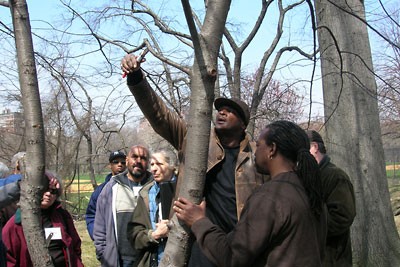Manhattan extension training is a walk in the park — with science and hands-on classes
By Susan S. Lang
Maintaining New York City's Central Park can be daunting: The 863-acre spread has 26,000 trees, and a quarter million flowers and plants are put into the ground each year for 25 million annual visitors. All that activity encouraged Cornell's Cooperative Extension (CUCE) in New York City to collaborate with the Central Park Conservancy (CPC) to offer a new 18-week certification course for park employees and volunteers.
Launched Jan. 30 and running through June 4, the CPC-funded Urban Horticulture and Ecology Training program brings expert instructors from various Cornell Cooperative Extension offices in the New York City region to lead weekly hands-on classes and laboratory and field exercises on such topics as botany, soil science, geology, turf management, weeds, trees, perennials, urban ecosystems and wildlife.
"The participants are learning the science behind the practical concepts that are taught," explains Gretchen Ferenz, a senior extension associate who leads urban environmental programs at CUCE-NYC.
When it comes to pruning, for example, the participants "learn how a plant grows and transports water and nutrients through its vascular system," says Ferenz. "Then they learn the direct application of that science to appropriate pruning practices to shape a tree, to invigorate a mature shrub, correct damage to a tree or shrub and remove diseased wood -- very practical hands-on practices."
From a grounds technician who preps planting beds and does lawn trimming to a landscape architect who works in the park department's design office, participants form a diverse group. Only two have had formal education in ornamental horticulture, says Ferenz. About one-third of the 36 participants are volunteers educated in professions other than horticulture working for the CPC, one-third are CPC employees working in Central Park and one-third work for the New York City Department of Parks and Recreation in parks citywide.
"The program is much needed, and if I could take this program every year I would," says Cornell Simmons, a CPC grounds technician taking the course. "People in the city need this type of program to be expanded."
Media Contact
Get Cornell news delivered right to your inbox.
Subscribe